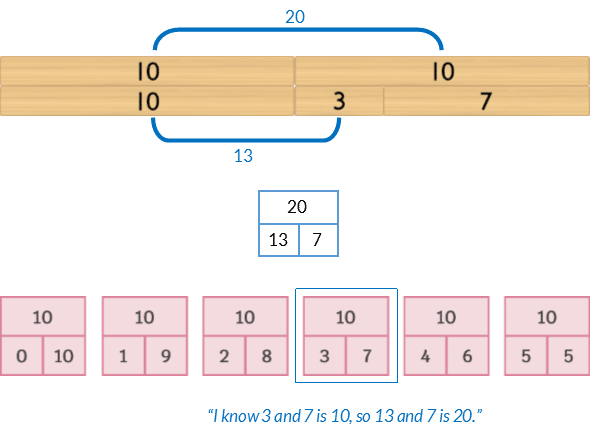47) Addition
Ten Plus Bonds: Building a Wall

Mathematics
Develop fluency with two-part ten plus bonds of 20 in addition equations, expressed verbally.
Language
- addition as “add”
- equals
- part-part-whole

Differentiation
A little easier
Working Memory Support: desk visual
Place bonds of 10 part-part-whole diagrams next to students, as a desk visual for them to refer to, whilst completing the activity. These diagrams can be useful supports for students with memory or processing difficulties.

There are a variety of visuals to chose from.
This visual shows all the two-part bonds of 10.
This visual shows the more difficult to remember two-part bonds of 10.
This visual is smaller and can be taped to the back of a ruler for discrete use by students who are older or self-conscious about using visual supports. It also contains the most difficult to remember double bonds.
This visual is the same as the smaller one above, except the bonds of 10 are in dark blue. This is to cater for students who are adverse to pink.
Click this link to read Teacher Notes for more ideas about “Using Part-Part-Whole Desk Visuals” to support students.
A little harder
Calculate: cumulative total
Each time the player spins and places blocks they score 20 points. Record this on a piece of paper as a cumulative total. The player with the highest score in 3 minutes wins. This develops fluency counting by 20.

A little harder than this is again: Players still score 20 points each time they place blocks, however they record this using tally marks. Each tally line is worth 20. This introduces the concept of multiplication as either:
- repeated addition. For example, seeing three tallies as 20 + 20 + 20.
- or multiplication. For example, seeing three groups of 20, 3 x 20.
Progression
In the next activity students apply ten plus bonds of 20 to subtraction equations that have missing parts. Go to
Activity 48
Ten Plus Bonds: Subtraction, Tic-Tac-Toe




